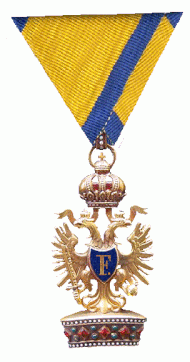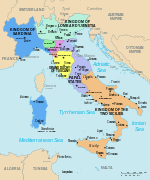Order of the Iron Crown (Austria)
This article includes a list of references, related reading or external links, but its sources remain unclear because it lacks inline citations. (March 2017) (Learn how and when to remove this template message) |
| Imperial Order of the Iron Crown | |
|---|---|
 Medal of the Order | |
| Awarded by | |
| Type | Dynastic order |
| Royal house | House of Habsburg |
| Awarded for | Civil and Military Merit |
| Status | Dormant Order since 2011 |
| Sovereign | Crown Prince Karl of Austria |
| Grades | Knight Grand Cordon with Collar, Special Class Knight Grand Cordon with Collar Knight/Dame Grand Cordon Knight/Dame Commander Knight/Dame |
| Precedence | |
| Next (higher) | Order of Leopold |
| Next (lower) | Order of Franz Joseph |
| Equivalent | Order of Elizabeth |
| Related | Order of the Iron Crown |
Ribbon of the Order | |
The Austrian Imperial Order of the Iron Crown (German: Kaiserlicher Orden der Eisernen Krone; Italian: Ordine imperiale della Corona ferrea) was one of the highest orders of merit of Austria and Austria-Hungary until 1918. It was re-established in 1815 by Emperor Franz I of Austria. The original Order of the Iron Crown had previously been an order of the Napoleonic Kingdom of Italy.
The order had three classes and all classes conferred automatic hereditary ennoblement; the third class conferred the rank of Ritter, the second class conferred the rank of Baron and the first class conferred the title of Privy Councillor, the style of Excellency, and the right to attend court. Appointment to the third or second class of the Order of the Iron Crown became one of the main routes to ennoblement for Austrian bourgeois families and for civil servants and military officers. The first class was in practice often awarded to people who were already noble. The order was also awarded to foreigners.
Contents
1 History
2 Insignia
3 Masters of the Order
4 Several of the order's knights
5 Sources
History
The Holy Roman Empire, ruled by the Habsburg dynasty, gave way to the Empire of Austria between 1804 and 1806. The last Holy Roman Emperor, Franz II, was proclaimed Emperor Franz I of Austria. His daughter, the Archduchess Maria Louise, was Napoleon’s second wife and Empress Consort, and the mother of Napoleon’s only legitimate son and heir, Napoleon, Duke of Reichstadt. With the collapse of Napoleon’s empire, Imperial Austria regained its traditional control of Lombardy as the Kingdom of Lombardy–Venetia.
The Austrian order was also divided into three distinct classes of knighthood, recognized as the First, Second, and Third Classes. Investment of this order carried an Imperial patent of nobility. With the collapse of the Austro-Hungarian Empire, in 1918, all but one (the Order of the Golden Fleece) of the chivalric orders of its monarchy were formally abolished.
Insignia
While the ribbon colors changed from the Imperial French gold and green to the Imperial Austrian gold and royal blue, the general look of the medal remained largely the same – an imperial eagle set within a representation of the Iron Crown of Lombardy. Grand Cross (French) and First Class (Austrian) knights wore a sash and badge over the right shoulder, with an eight-pointed star (that featured the Iron Crown at its center) on the left breast. Imperial French knight commanders wore a traditional military style medal on the left chest, with the addition of a bow in the center of the ribbon to delineate them from ordinary knights. Imperial Austrian Second Class knights wore the medal suspended from a ribbon about the neck. French ordinary knights and Austrian Third Class knights wore a traditional military medal on the left chest.
From 1908 for First Class knights, and from 1917 for Second Class knights, the Imperial Austrian order allowed for an undress version to be worn with service dress. First Class knights were authorized to wear a Third Class military medal on the left breast, with an addition of a device known as a "Kleine Dekoration". The pin device was a miniature version of the First Class breast star, and was worn on the center of the ribbon to delineate the wearer as a knight of the First Class. Variations in the star matched the details of the knight's specific award: including the war decoration wreath and the crossed swords. The Second Class Kleine Dekoration was a miniature depiction of the Iron Crown of Lombardy (copied from the lower part of the actual medal). As with the First Class knights, the Kleine Dekoration for the Second Class knights matched the award to the knights: crown only for peacetime award, crown encircled by a wreath for the war decoration, and topped with swords for those awards "with swords", and was worn in the same fashion as that of the First Class knights.
During World War I, awards "with swords" were given to symbolize personal valour of the knight that led to his award. Hence, ordinary knights medals were also frequently adorned with crossed swords, pinned to the tri-fold ribbon.
 | ||
Ribbon bars | ||
Knight Third Class | Knight Second Class | Knight First Class |
Masters of the Order
Franz I, Emperor of Austria, 1816–1838
Ferdinand I, Emperor of Austria, 1838–1848
Franz Josef I, Emperor of Austria-Hungary, 1848–1916
Karl I, Emperor of Austria-Hungary, 1916–1918
Several of the order's knights
- count Aymard d'Ursel
Augusto Carlos Teixeira de Aragão (1823-1903)- Hauer Lipót (1854– 1933)
- Michael Ludwig von Appel (1856 – 1915)
- Karl Křitek (1861 – 1928)
- Karl von Kirchbach auf Lauterbach (1856 – 1939)
- Hugo Martiny von Malastów (1860 – 1940)
- Karl Georg von Huyn (1857 – 1938)
- Friedrich von Georgi (1852 – 1926)
- Arthur von Bolfras (1838 – 1922)
- vitéz Sándor Farkas de Boldogfa (1880-1946)
- Árpád Szekrényessy von Székelyhíd (1849 – 1917)
- vitéz Miklós Kozma von Leveld (1884 – 1941)
- vitéz Viktor Lorx von Ruszkin (1873 – 1922)
- vitéz Kocsárd Janky von Bulcs (1868 – 1954)
- vitéz Rezső Metz Spondalunga (1861 – 1943)
- baron Rudolf Stöger-Steiner von Steinstätten (1861 – 1921)
- Ágoston Kubinyi von Felsőkubini et Nagyolasz (1799 – 1873)
- vitéz Miklós Horthy von Nagybánya (1868 – 1957)
- baron Hermann Kövess von kövesháza (1854 – 1924)
- Gyula Bauer (1862 – 1940)
- Baron Ludwig von Welden (1780 – 1853)
- Sándor Wekerle (1848-1921)
- Ferenc Szálasi (1897–1946)
- count Heinrich von Lützow zu Drey-Lützow und Seedorf (1819–1900)
- count Ödön Széchenyi von Sárvár-felsővidék (1839-1922) pasa
- József Stoczek (1819–1890)
- Kruspér István (1818–1905)
- Kálmán Szily von Nagy-szigeth (1838–1924)
- dr. Alajos Hauszmann von Velencze (1847–1926), architect
- baron vitéz Sándor Szurmay von Uzsok (1860–1945)
Ányos Jedlik (1800–1895)- Baron Samu Hazai (1851–1942)
- Mihály Munkácsy (1844–1900)
- Emanuel Stross (1841–1913)
Sources
- Blom, Philipp. To Have and to Hold: An Intimate History of Collectors and Collecting. Overlook, 2003. pp. 146–147.
- Gottschalck, Friedrich. Almanach der Ritter-Orden. Leipzig, Kingdom of Saxony: Georg Joachim Goeschen, 1819.
- Austrian Biographical Encyclopaedia and Biographical Documentation
| Wikimedia Commons has media related to Order of the Iron Crown. |


